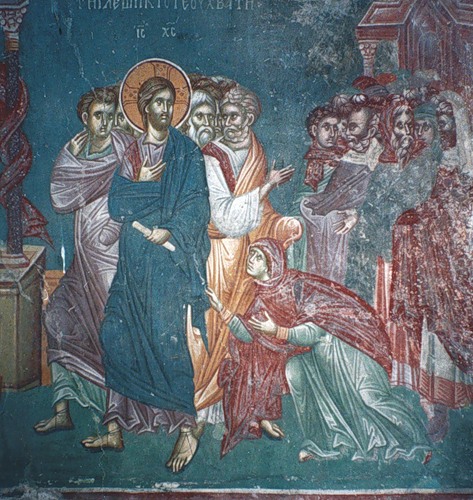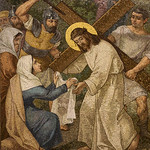Touching the untouchable
by Sr Ann Catherine Swailes
Evensong Sermon, Clare College Chapel, February 16th 2020 (Matt. 9.20-22; Mark 25-9; Luke 8.43-48)

In our exploration together of encounters with Jesus, we have this week something of a mid-term special offer: two for the price of one. Or, rather, more- potentially infinitely more - than two for the price of one. Because behind and within the stories of the two women we have just heard we can discern in outline stories of other encounters with Jesus. Even, perhaps, our own.
I said the stories of the two women, but perhaps it would be better to say the story. When the woman with the issue of blood appears on the scene, she interrupts a narrative already in train – the Lord has started out on his way to the house of Jairus when she pushes her bashful way through the crowd. But it’s not just an interruption; and nor are these two random snapshots of a day in the life of Jesus, which just happen to be juxtaposed, with no intrinsic connection between them.
There are striking differences between them, of course: Jairus’ daughter raised from her untimely deathbed, and the woman whom Jesus calls daughter as he restores to her the energy of a youth long-lost; Jairus’ daughter at the centre, surrounded by a crowd of anxious friends and relatives, her father, pillar of the community that he is, for her sake placing his reputation very publicly in the hands of the latest sensation to raise respectable eyebrows; the anonymous woman with no reputation to lose reaching out with a tentativeness born of the years on the periphery to which her condition has exiled her.
But for all the contrasts between these two women, there’s a kind of solidarity between them too, born of the extremity of their common need, symbolised by that coincidence in timescale that the gospel account underlines: for the entirety of the dying girl’s life the woman has been bleeding, and it has doubtless come to seem a lifetime to her, too. And I think the story of their encounters with Jesus can point to a similar possibility of encounter for us, especially in those moments when our own need, or the need of those we love, is extreme. This is so, whether suffering comes like the unforeseen and dramatic extinguishing of light and promise we see in the house of Jairus, or like that gradual but inexorable attrition of hope summed up so tellingly by St Mark in that little detail of the older woman’s history omitted by St Luke from the version in his gospel out of professional courtesy towards his fellow medics: she has spent all she had on doctors, Mark tells us, and grew no better, but rather worse.
Their joint story is especially consoling, I suggest, for a reason that, at first sight, probably seems anything but, reliant as it is on concepts that we are more likely to find baffling and disturbing. The woman who touches Jesus’ garment is, in terms of her own religious culture, ritually unclean, to all intents and purposes untouchable. So, for that matter, is Jairus’ daughter at the moment of her encounter with Jesus. Death, like the gynaecological condition to which the gospel writers and their translators somewhat reticently allude, places one in that category. We do not have time tonight – and I am far from possessing the competence – to explore the nuances of this concept. What is important for us to note is that ritual impurity is, precisely not moral inadequacy. It is not the woman’s fault that she is bleeding, any more than it is Jairus’ daughter’s fault that she is dead. And ultimately, therefore, both of them show up the falsity of that darkly seductive notion that lurks in the hidden places, sometimes, of even the most luminously rational minds; the notion that when we are going through the mill we must somehow deserve it, and that in consequence we ought, somehow, to pull our suffering selves together, stop whingeing, keep calm and carry on. The encounters with Jesus we have heard tonight forbid this kind of lazy equation of either suffering with punishment, or Stoic self-control with Christian virtue. It is all right for a figure at the heart of the establishment to lose his cool and harangue the Lord for fear of losing his precious daughter; it is all right for those whose voices are muted by shame and weariness surreptitiously to brush the fringe of his garment instead; it is all right for us to cry out or stretch out to him however extravagantly or timidly, when our hearts are stunned by pain. It is all right to be weak, there is no need to hide our need.
And this is what we would expect if we attend to who it is whom the women in our story tonight encounter in their encounter with Jesus. For classical Christian theology, every meeting with Jesus is a meeting between heaven and earth, because in Jesus himself, heaven and earth meet: Jesus is the one who is both truly divine, and truly human. Because he is divine we might expect him to perform mighty acts, and drying up fountains of blood and raising the dead definitely count as examples of that. But just what kind of God is this? Another encounter with Jesus, in which some have seen the sequel to the one we have just heard read, might provide some clues, and help us to read this story afresh, as good news for us all.
There is an ancient tradition of another occasion when a woman pushed her way through the crowds to Jesus, not, as here, when, in the springtime of his ministry, he is carrying all before him, but when as a condemned criminal, he carried his cross to Calvary. She, it is said, takes the immense risk of approaching that sad little procession, and wipes the face of the man labouring under his burden with her handkerchief. Catholic and Orthodox Christians know her as Veronica, the one, that is, who bears the true image of Christ. There is a legend that the image of Christ’s face is miraculously imprinted on the cloth she holds out to him. More fundamentally, perhaps, she, in the courage and compassion she offers the Lord presents us with a picture, a true likeness of the costly love that he, the Lord offers to all of us.
From at least the fourth century, a connection was made between Veronica and the story we have heard tonight. Veronica, on this account, is none other than the woman healed by Jesus as he was on his way to raise the little daughter of Jairus from death.

There is a breath taking parallelism in the two incidents, and, if the woman healed of the issue of blood really did become Veronica, she surely could not have been unaware of that symmetry. Then, on that day when the violence of her need drove her to it, she grasped at the fabric Jesus wore; now, on the first Good Friday, she offers him, with shattering gentleness, a cloth with which to comfort him in his distress. He had dried up the blood which drained from her, exhausting her and bringing her shame; she wipes the blood from his face, moved by compassion, surely, for his degradation as much as for his physical suffering.
That Veronica may have been one whom Jesus had touched in this way suggests beautifully the connection between compassion and gratitude; not that there is some dutiful calculation to be made between God’s gifts to us and the price we put on them, as though we owe just this much service to our fellow men and women in return for what God has done for us, and no more. But in the scene of Veronica shoving her way to the front of the crowd surrounding Jesus en route to his execution, we see compassion energised by gratitude. We see her doing this thing because she can’t not do it, can’t not be for Jesus what he has been for her, standing beside him in his need as he came to be with her, savingly, in hers. And the sign of her salvation is that she can do this, that she can minister God’s compassion to God himself and thereby become most truly and clearly his image.
There are many Veronicas in our world today, and you don’t have to go far to find them, but then, nor do you have to go far to find Jesus walking his way of the Cross. If, as St Paul tells us, the Church is the body of Christ, our suffering, the suffering of our brothers and sisters, is his suffering. This is good news first of all because it suggests that there is a direction to that suffering, that all our crucifixions will lead, as did his, to resurrection, to a restoration to abundant life like that held out to both Jairus’ daughter and the anonymous woman, freed as they both are from deathly constriction by the touch of the Lord.
But there is something else for our consolation here too. If our own suffering is thus taken up into the suffering of Jesus, even when it seems to humiliate and defeat us, we can still be assured that we have the dignity of sons and daughters of God, the dignity of Jesus himself. And, in comforting others in their distress, we are actually walking with Jesus himself on his way to Golgotha. There are many Veronicas, many ways of being Veronica, just as the suffering of Christ in the members of his body takes many forms. I think of the students in the Fisher House St Vincent de Paul Society, who go nightly onto the streets of Cambridge, giving soup and sandwiches to the homeless, but also offering them the tender and sometimes costly and courageous touch of companionship. I think of an elderly man refusing to allow his own fear and grief to prevent him from ministering consolation to his wife of decades as she confronts the passion of dementia. I think of those experiences of suffering in all our lives, when, in the comfort we give to or receive from our friends, the face of Christ is wiped again.
And in all those moments of charity and compassion, lost childhood is restored, life and energy renewed, and the Lord says to each one of his suffering brothers and sisters, to each one of us, go in peace.